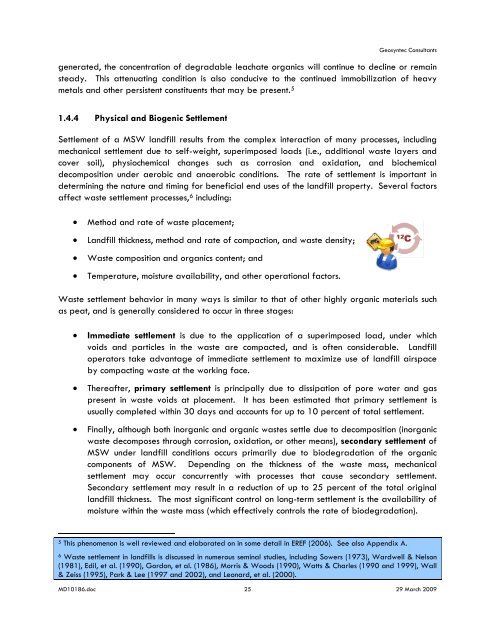AREA A/B ENGINEERING REPORT - Waste Management
AREA A/B ENGINEERING REPORT - Waste Management
AREA A/B ENGINEERING REPORT - Waste Management
Create successful ePaper yourself
Turn your PDF publications into a flip-book with our unique Google optimized e-Paper software.
Geosyntec Consultants<br />
generated, the concentration of degradable leachate organics will continue to decline or remain<br />
steady. This attenuating condition is also conducive to the continued immobilization of heavy<br />
metals and other persistent constituents that may be present. 5<br />
1.4.4 Physical and Biogenic Settlement<br />
Settlement of a MSW landfill results from the complex interaction of many processes, including<br />
mechanical settlement due to self-weight, superimposed loads (i.e., additional waste layers and<br />
cover soil), physiochemical changes such as corrosion and oxidation, and biochemical<br />
decomposition under aerobic and anaerobic conditions. The rate of settlement is important in<br />
determining the nature and timing for beneficial end uses of the landfill property. Several factors<br />
affect waste settlement processes, 6 including:<br />
• Method and rate of waste placement;<br />
• Landfill thickness, method and rate of compaction, and waste density;<br />
• <strong>Waste</strong> composition and organics content; and<br />
• Temperature, moisture availability, and other operational factors.<br />
<strong>Waste</strong> settlement behavior in many ways is similar to that of other highly organic materials such<br />
as peat, and is generally considered to occur in three stages:<br />
• Immediate settlement is due to the application of a superimposed load, under which<br />
voids and particles in the waste are compacted, and is often considerable. Landfill<br />
operators take advantage of immediate settlement to maximize use of landfill airspace<br />
by compacting waste at the working face.<br />
• Thereafter, primary settlement is principally due to dissipation of pore water and gas<br />
present in waste voids at placement. It has been estimated that primary settlement is<br />
usually completed within 30 days and accounts for up to 10 percent of total settlement.<br />
• Finally, although both inorganic and organic wastes settle due to decomposition (inorganic<br />
waste decomposes through corrosion, oxidation, or other means), secondary settlement of<br />
MSW under landfill conditions occurs primarily due to biodegradation of the organic<br />
components of MSW. Depending on the thickness of the waste mass, mechanical<br />
settlement may occur concurrently with processes that cause secondary settlement.<br />
Secondary settlement may result in a reduction of up to 25 percent of the total original<br />
landfill thickness. The most significant control on long-term settlement is the availability of<br />
moisture within the waste mass (which effectively controls the rate of biodegradation).<br />
5 This phenomenon is well reviewed and elaborated on in some detail in EREF (2006). See also Appendix A.<br />
6 <strong>Waste</strong> settlement in landfills is discussed in numerous seminal studies, including Sowers (1973), Wardwell & Nelson<br />
(1981), Edil, et al. (1990), Gordon, et al. (1986), Morris & Woods (1990), Watts & Charles (1990 and 1999), Wall<br />
& Zeiss (1995), Park & Lee (1997 and 2002), and Leonard, et al. (2000).<br />
MD10186.doc 25 29 March 2009

















